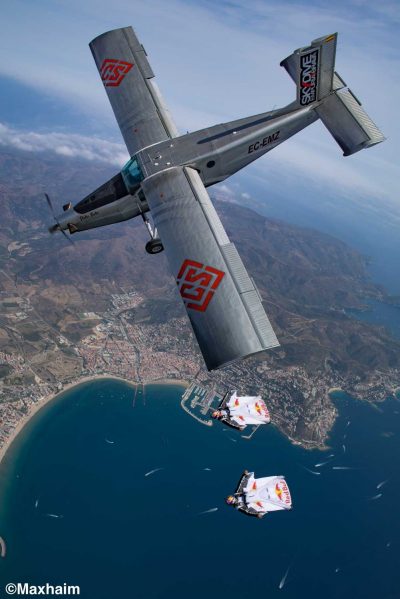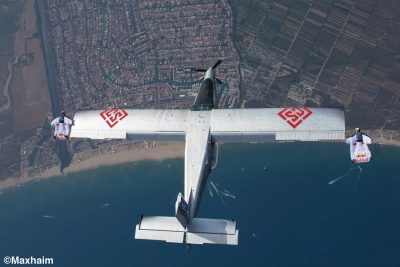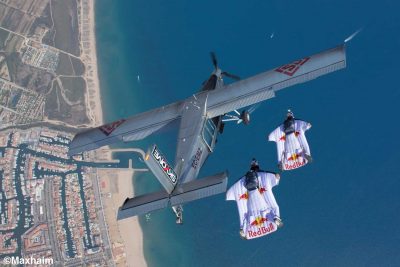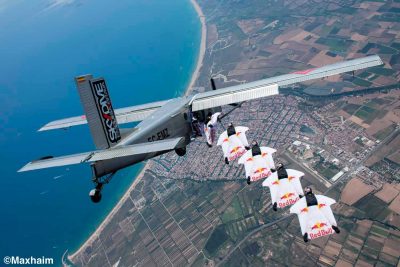
Fred Fugen and Vince Reffet on “A Door In The Sky”
Tuesday, August 7, 2018
- Team CYPRES
- 8/07/18
- 0
- General, Sponsored Athlete
Fred Fugen and Vince Reffet Needed Backup. We Were It.
If you’re reading this article, you’ve definitely seen it: “A Door in the Sky.” In this jaw-dropping piece of short freefall cinema, we see everyone’s favorite airports bros—Soul Flyers Fred Fugen and Vince Reffet—jumping off a mountain in their wingsuits and proceeding to zip right into the door of an airplane in flight.
You already know that “A Door in the Sky” is one of the most challenging, interesting and photogenic undertakings ever to happen in the airsports world. You might also know that it was an anniversary hat-tip to Patrick de Gayardon’s also-famous skydive-back-into-a-plane stunt, done 20 years ago, and that Fred and Vince wanted the Door In the Sky event to occur on the same date.
You are currently viewing a placeholder content from YouTube. To access the actual content, click the button below. Please note that doing so will share data with third-party providers.
What you might not know—especially since the event was a BASE jump—the key role that CYPRES played in the stunt being pulled off safely.
“The final goal of the project ‘A door in the sky’ was to jump from a mountain and fly back into the plane,” Fred starts, “but to do this we had to use a single-parachute, BASE jumping system that doesn’t have any safety devices in place in case you get knocked out.”

“When we started with the project and had this dream of jumping from the mountain,” Vince adds, “It was quite scary, in a way. It is technical to do this from a mountain because you have a BASE rig and no safety device. Even to do it in training—jumping from the plane and reentering—it can be dangerous as well.”
The pair goes on to explain the resultant strategy: That they would, before going to the mountain, do a bunch of training at their home base of Skydive Empuriabrava to get themselves—and the pilot—used to flying back into the plane.
The need for a wingsuit CYPRES was glaringly obvious. Few skydivers undertake training that has them intentionally flying at the plane with a high likelihood of at least minor impact…and that is exactly what Fred and Vince were about to do.
“At the beginning,” he adds, “There was a sense of the unknown. Who can know what to expect? If you knock yourself out on the plane, then you can end up unconscious. If you don’t have a wingsuit CYPRES and that happens, you don’t wake up.”
“With the device,” Vince adds, “We knew that if we hit the plane and were knocked out, we would survive.”
The pair knuckled down to the task of training the stunt. In total, they did about a hundred training flights with the plane in Empuriabrava, spending about four months of “full-on jumping,” working with their pilot and the rest of their support team. On each successive flight, they worked with their target plane’s pilot to dial in the approach. They got closer and closer, eventually doing some touches. Finally, after eighty flights, they decided together that it was time to try the re-entry.
“For us, the training was really the very big important part,” Fred notes, “because that’s where we learned to fly with the plane in formation, and that’s where we learned how to fly back into the plane.”
“Before we were ready to do it from a mountain,” he continues, “we had to be prepared. We had to do a lot of training to make sure we understood the trajectories correctly. And we knew that, during the training, we had to have skydiving rigs with reserves and with the wingsuit CYPRES.”

“You have to train with everything on your side,” Vince adds, “so if it goes wrong, then you will be safe with your reserve. Having the [wingsuit CYPRES] device was part of the success of the training.”
After Fred and Vince successfully flew back into the plane ten times each in the skydiving context, they knew they were ready to take it to the BASE environment.
“When we did it from the mountain, we knew the territory,” Fred smiles. “We had seen all the worst cases during the training, so the day we went to the mountain, we were prepared 100%.”
Luckily, the worst cases weren’t that bad. As it turns out, neither Fred nor Vince came anywhere close to firing their CYPRES units during training. They did, however, take various other dings and bruises, some of which left quite a mark. Even though the aircraft doorframe and interior was girded with foam, the pair took “some pretty good impacts” over the course of the training. Vince hurt his rib; Fred hurt his foot. Neither man hit his head—but neither man would have dreamed of doing the training without a CYPRES device.

“When you see the final result,” Fred muses, “You don’t think about the CYPRES, which is a small device that’s hidden in your rig. But when we are doing training in skydiving, we want to use this specific device to help us to be safer while we are learning something that is dangerous. It is scary enough to try to fly back into the plane when you don’t know how to do it. It is important to have this backup on our back.”
“We come from a family of skydivers,” Vince notes. “Our parents used CYPRES [units] from the very beginning. They gave me a CYPRES [unit] as a present when I was 15 and I got my first rig, and for all those years of competition, we have been with CYPRES. For us, there is no other. There is no question of the trust that we have in CYPRES to feel safe.”
“I feel the same as Vince,” Fred adds. “I’ve always jumped with CYPRES, for more than 20 years, and we have been sponsored by CYPRES for about 15. In that time, CYPRES has always adapted to changes in the sport. In the early 2000s, we started jumping smaller canopies, so CYPRES started the CYPRES Speed.”
“Now that wingsuiting is getting bigger and bigger,” he continues, “they have done a similar thing, adapting to this new market, and created a device that will save you in case of a problem. They are making sure it is there to save life when you cannot make the action.”
Fred and Vince are in the business of pulling off miracles, too—but they’re just as dedicated to process and to safety as their CYPRES supporters. Both athletes are keen that skydivers know just how much of an arduous, painstaking process this miraculous-looking stunt has been. To that end, they have worked to obtain permission from the project sponsors to show raw training footage.

“When people see how hard we crashed into that plane and what it took for us to do this,” Vince says, “I think they will understand exactly why we are using this device when we wingsuit.”
“It was really teamwork, this whole project,” insists Fred. “It was a big deal to fly back into that plane. Okay, the two of us are on video doing it, but without the whole team, ‘A door in the sky’ would have never happened, like most of the projects we do. It is the teamwork that drives it. Without a great team, it is hard to achieve great things.”
Tags: A Door in the Sky, Fred Fugen, Max Haim, Skydive Empuriabrava, SoulFlyers, Vince Reffet, Wing Suit
Adventure, Tips, and Adrenaline
Subscribe to Our Newsletter
By signing up for our newsletter you declare to agree with our privacy policy.

